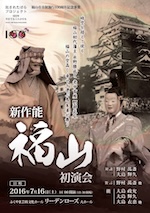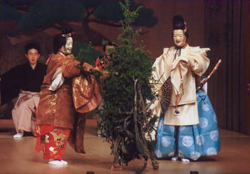The Newly-Produced Noh
The Newly-Produced Noh Piece "Fukuyama"
 the premiere pamphlet of the newly-produced Noh piece
the premiere pamphlet of the newly-produced Noh pieceAbout 650 years ago, Kan-ami and Ze-ami in Muromachi Era organized Saru-gaku and Den-gaku and completed a new performing art, with the technique now called Mugen-Noh. Most of its sources are the Japanese classics: the Tale of Ise, the Tale of Genji, the Tale of Heike and so on. Nowadays around 240 pieces are available, in which 80 odd are well performed. During Edo Era, making a new Noh piece was prohibited, while after the Meiji Restoration modern Noh pieces appeared gradually, which were called "newly-produced" Noh pieces. Recently the new Noh pieces are created and performed vividly. The ones in rural cities, however, are pretty rare. The Noh piece "Fukuyama" deals with the history and tradition of the city during Edo Era, which was produced and performed in 2016 (Heisei 28) in commemoration of the 100th anniversary of Fukuyama Municipal System. It was again performed in 2022 (Reiwa 4), on the 400th Birthday of Fukuyama Castle.
The newly-produced Noh Piece "Tomo no Muro-no-ki" HOASHI Masanori
 Shite OSHIMA Masanobu, Tsure OSHIMA Kinue
Shite OSHIMA Masanobu, Tsure OSHIMA KinueThis Noh piece was derived from the poems by OTOM no Tabito, in Man'yo-shu Vol. 3. Tabito recalls his dead wife, gazing at the tall Muro tree at Tomo no Ura which they once admired together on the way to Dazaihu where she died. How sorrowful not to be with the wife, who looked up the tree beside him sympathetically. I put the sorrow in the heart of this piece.
(partly omitted)
When I got a request of writing a new Noh piece about the material concerning Bingo Fukuyama, that poems by Tabito floated through my mind first of all. The place of Tomo no Ura has been attracting me for a long time. That is one of my favorite places and I visited the town several times. And while I was writing the piece, I often went there and became familiar with some of the local people.
(partly omitted)
If you write a new Noh piece, you cannot overwhelm such masterpieces as "Izutsu," following the style of the classics. And if you adopt a new style, it just falls into curiosity unless there must be a logical necessity of art. These are, these used to be, my words to refuse a request of writing a new Noh piece. It is really from my heart, mixed with a bit excuse of an idler.
But Ms OSHIMA Yasuko, Mr OSHIMA Masanobu's wife, woke me up from the lazy doze. She is an expert manager, is good at encouraging people around her, and we are willing to take her intention. Now, I am grateful to have this opportunity.
Beginning the job, I realized that I was following the old classical style, which has soaked through myself anyway. I decided to face it, even though I would be overcome. Watching its trial performance, I was relieved to find that it came out to form an ordinary one. Asked at the press conference if we performed something fresh, Mr OSHIMA Masanobu answered, "I do not want to do anything fresh." Both Shite-kata and the writer agreed, and all the party involved in performing this newly-produced "Tomo no Muro-no-ki" also understood my intention, which is my happiness from my heart.
from the pamphlet of the premiere on June 15, 2002
WHY WRITE A NOH PLAY? Jannette Cheong
 Shite OSHIMA Kinue, in 2011
Shite OSHIMA Kinue, in 2011The character for 'Noh' in Chinese means 'can' --- the verb used to indicate that it is possible for something to be done.
I was fortunate to meet the Oshima family at their theatre in Fukuyama in November 2007 at a time when I was working on a piece for Western musical theatre. It was the Oshimas' interest in this work, their kindness in thinking that my story might make a Noh play, and their dedication to their art, that inspired me to consider taking this fascinating journey into the world of Noh. 'Serendipity' is the 'discovery of something fortunate', and the 'gift for discovery'. Both underpin the making of Pagoda.
The Oshima family and friends introduced me to Richard Emmert, one of the few Westerners with the skills, experience, passion and generosity of spirit to collaborate on such a project. Rick first encouraged me to attend a Noh Writer's Workshop that he was running in the USA, and then, with the help of twenty-first century technology (the Internet), acted as my mentor in this classical art form --- Rick, working from his base in Tokyo and myself working from the French Pyrenees. For nearly four months I shut my self away to let the beauty of the mountains combine with my thoughts of the life-changing experiences that happened to me more than 30 years ago. Rick helped me understand how I could use the structure and discipline of Noh to interpret these into a Noh play.
I wanted to draw on two stories that had stayed with me all this time. The first was how I found my father's birthplace in China in the 1970s at a time when China was virtually closed to the West, and what I learnt about his childhood and family. The second was the legend of a Pagoda local to his native province. The stories had a common subject --- courageous women --- one rich, in the case of the Pagoda legend, and one poor, my Chinese grandmother, who both lost loved ones in tragic circumstances, and never gave up hope. But, the story of Pagoda Noh also has a subtext--- identity and migration. People of mixed race often wonder about their identity. The writing of Pagoda has enabled me to explore who I am and where I have come from. It has also helped me to understand that migration is as old as mankind itself.
When I first saw Noh performed I was not aware that it was a 'cultural treasure', nor was I particularly concerned that I did not understand it, or its stories. I just considered it a beautiful art form. In the Noh world, artistic practice generally precedes meaning --- though the search for harmony between form and function is as important to Noh as it is any art form. However, Noh has many structures and conventions. Writing for Noh involves respecting these, but at the same time, within these conventions, the writer has a great deal of freedom of expression. Once familiar with the conventions of Noh the art form reveals itself and no longer seems impenetrable and esoteric, but rather liberating and unrestrictive.
I have learnt much about Noh and the structural elements of Noh by 'doing' ie writing a Noh play. Interestingly, writing for Noh has also enabled me to explore aspects of Chinese as well as Japanese culture. But those with whom I have been fortunate enough to work over the last two years have devoted their entire lives to 'perfecting their art'. They have enabled me to get close enough to the art of Noh to allow it to captivate me and tease out the images in my mind to tell this Story in the way Noh allows.
I will continue to worry about whether the jo-ha-kyu is right, and whether I have been sufficiently faithful to the traditional Noh conventions for Pagoda to be 'accepted' as a Noh play. Perhaps this personal story will be as inspirational to the performers of Pagoda as the complete adherence to the rules of Noh. It is for others to judge whether we have managed to respond well to both challenges. I hope, like me, our audiences will grow to understand a little of what Noh has to offer --- to art and to our understanding of life.
I am now working with Ruth Chan on a chamber opera using the Noh libretto, and in China there is also interest in develdoping a film based on the same story.
Autumn leaves drift west and east, and east and west ---.
